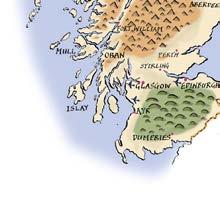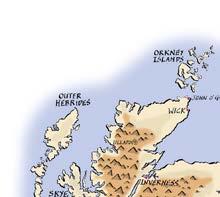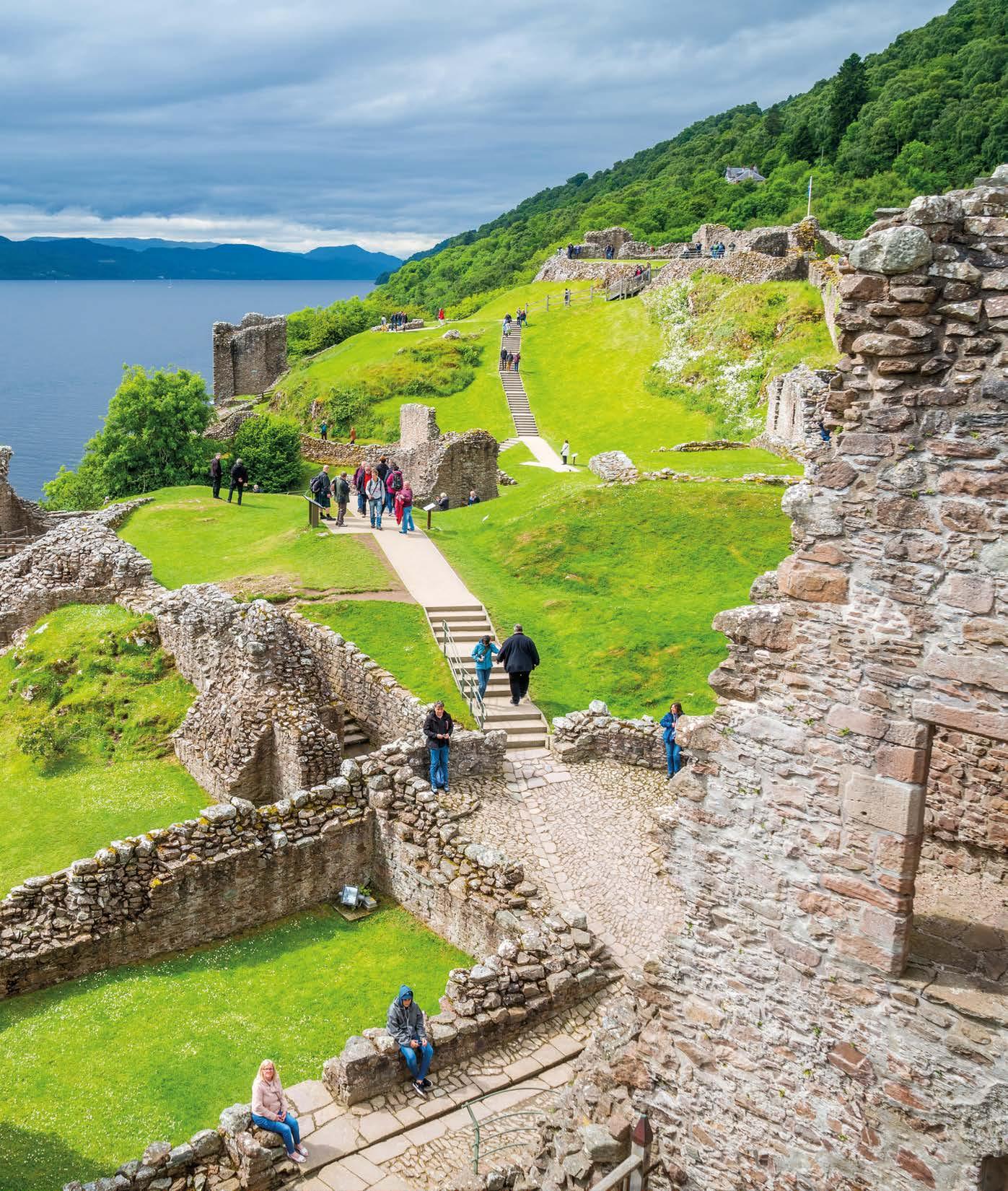


























































































Orkney considers breaking free, the King enjoys a wee dram and a Skye inn is for sale

Councillors in the Orkney Islands are considering a Brexit-style break from the UK after being “failed dreadfully” by the governments in Edinburgh and London.
At a council meeting in July, council members, frustrated at the poor level of funding coming its way, voted 15 to six to explore ‘alternative modes of government’. Among different options being explored is the idea of returning to Norway, which ruled the islands until 1472 when they came to Scotland as part of the dowry of Margaret of Denmark, wife of King James III.
The leader of the Orkney Islands Council, James Stockan, told the BBC: “We were part of the Norse kingdom for much longer than we were part of the United Kingdom.
“On the street in Orkney people come up and say to me, when are we going to pay back the dowry, when are we going back to Norway?
“There is a huge affinity and a deep cultural relationship there. This is exactly the moment to explore what is possible.”
The council will also look closer at other Crown Dependencies, such as the Channel Islands to see how they are run.

ABOVE: Kate and Cronie, her faithful Border Terrier

OPPOSITE PAGE: A yacht waiting to enter the Caledonian Canal sea locks in early summer
Words by KATE FRANCISMy brother-in-law, David, a widower for three years, was still at school when my parents-in-law bought this dear old farmhouse in 1952, and he shares my love of the Highlands despite living in England and having spent a nomadic life as a diplomat.
Recently, David decided to organise an octogenarian jaunt for some of his contemporaries from Oxford; the plan was to lure them north and take them on a tour of his favourite places. There were eight of them, plus him, and my daughter Mary was their tour guide for a week – something she is well quali ed for, as an architectural historian and writer.
They had a bus and driver and began their expedition from Inverness – having once written a tourism guide to the Highlands and Islands, I couldn’t fault David’s itinerary. Day one included Culloden Battle eld and its excellent visitor centre; 14th-century Cawdor Castle and gardens; and the amazing Bronze Age burial site at Clava Cairns, where excavations revealed cremated bodies, pottery and other memorials of people who lived 4,000 years ago.
That night they came here for supper, to inspect their host’s childhood home. (My Douglas, being several years older, had already joined the army when the family came to live here so he never had a room of his own, just a bed in a corrugated iron shed in the garden
with no mod cons). David insisted that, rather than coming to the back door, where it’s possible to park cars, and in through the kitchen, the group would arrive through the front gate, up the paved path, over the terrace and in through the front door. I did some super cial weed-snapping between the paving stones and cut back a cornus so that they didn’t have to crawl through the gate on hands and knees, and they seemed suitably impressed by my ‘wild’ garden. There were 11 of us and it was like a delightful gathering of prep-school alumni as they exchanged jokes and old stories round the table. I hope everyone enjoyed it as much as I did. They all had second helpings of my coronation chicken and blueberry cheesecake.
Having had their Jacobite education at Culloden, the next day they went to the Wardlaw Mausoleum, built for the Lovat Frasers in 1634. Simon Fraser, 11th Lord Lovat, known as the Old Fox and famous for his somewhat devious loyalties to both the House of Hanover and the Stuart cause, nally supported the Jacobites. For this, he was arrested, taken to the Tower of London, and executed in 1747.
Simon Fraser was buried in London, but his family nally managed to transfer what they believed to be his cof n to Wardlaw so he could rest in peace with his ancestors. However, when the double-leaded casket was opened not long ago, it contained the skeleton of a woman, with no head, and some children’s bones. There are many theories for this enigma but it hasn’t been solved yet and the whereabouts of the Old Fox is still a mystery.
The group nished their tour up in Skye, with plenty of







Our friend plays happy host once more, though there are some ‘guests’ she would rather not have to deal with at all
historic sites to visit, including the Clan Donald Centre and Museum at Armadale Castle – a necessary part of the tour because the Macdonalds gave David his Scottish blood – and Dunvegan, seat of Clan MacLeod, the oldest continuously inhabited castle in Scotland.
My favourite relic at Dunvegan is the Fairie Flag, a tattered silk 4th-century relic, with many differing stories of its origins. Thought to be Syrian, it might have been brought back from a Crusade to the Holy Land, by a MacLeod chief. Whatever it’s provenance, it’s believed to have the power to bring victory in war to its bearers and has already done this twice for the MacLeods in their defeat of the Macdonalds. However, it has a limit of three uses, after which it will bring disaster.
Sitting here on my terrace, basking in sunshine, and serenaded by birdsong, it seems impossible to imagine that there could ever be another reason to wave the Fairie Flag. Gazing across a mirror-like firth dotted with sailing boats, to hills so recently snow-capped, I marvel yet again at those of my neighbours who choose to pay a fortune to queue for hours at airports and then spend a couple of weeks on a crowded beach abroad. Walking along the shore with Cronie this morning, I was filled with joy at being so lucky to live here; there’s no other place where I would rather be.
The briars are in full, aromatic bloom: pink, white, and creamy, with foxgloves – and of course thistles – pushing up among them. An otter was so engrossed in devouring a fish that it didn’t run away when we passed. Herons stood vigilant on the rocks; a flock of curlews flew out over the water, chased
by shrieking oystercatchers; a motorboat full of tourists went past, looking for dolphins. Three yachts were queuing up in the distance, to enter the first lock of the Caledonian Canal, thereby taking a short cut over to the west coast.

Scotland may seem perfect, but there are a couple of cons to the millions of pros: ticks and midges, both of which are particularly abundant this year. Bracken, heather and deer are among the favoured hosts to ticks and these are prevalent on most of Cronie’s and my walks. My blood must be especially delicious, because I seem to return from each walk infested with them, although they’re easy to evict when visible, they tend to go for the most inaccessible parts of the body, from where it’s impossible to gouge them out.
Having once had Lyme’s disease I know one must be vigilant and I notice the tell-tale red ring that forms around the bite, but that’s tricky when the bite is out of sight. I’ve now invested in an anti-tick spray that you squirt all over yourself and that seems to be working – at least for the moment. For Cronie, there are pills, costing £40 for three! There’s nothing you can do about midges except swat them and be stoical. S
Herons stood vigilant on the rocks; a flock of curlews flew out over the water, chased by shrieking oystercatchers


From monster-spotting to clan history and blockbuster scenery, here’s how to make the most of your time in the Highlands
 Words by SALLY COFFEY
Words by SALLY COFFEY


PREVIOUS PAGE:
The Scottish Highlands is a place of epic landscapes, where legends and stories permeate the heathercoated hills and glassy lochs – some of them true and some of them perhaps not.

It’s renowned for its haunting beauty, from its ruined castles that speak of tragic love stories, families split by allegiances, and merciless power battles to vast areas of natural beauty with empty white sandy beaches at their fringes and small communities hidden within, as mighty Munros all around guard their secrets.
Unless you have several weeks or more to explore the Highlands, you won’t see it all – not even close – but luckily many of the Highland’s most iconic places are within easy travelling distance of each other, making an itinerary that reads like a bucket list of Scotland’s most memorable experiences highly achievable: Loch Ness, Ben Nevis, Glen Coe, and Glenfinnan.

There are two main ways to reach this Highlands heartland. You can travel from Glasgow by road or train, up through Loch Lomond and The Trossachs, skirting along Rannoch Moor before crossing through Glen Coe to reach Fort William and the great hulk that is Ben Nevis.
From here, you can board the Jacobite Steam Train to cross the famous Glenfinnan Viaduct, or follow the route of the Great Glen up from where it spills into the sea at Loch

Storytelling is in the blood in Scotland so it’s no wonder the story of the enigmatic Loch Ness Monster has endured



Linnhe all the way to Loch Ness.
For this piece, we’re taking the other route, from Inverness, which plunges you into Highland scenery within minutes of leaving the city.

For very soon you will reach the shores of Loch Ness, the largest of all Scottish lochs by volume – it is said that if you took all the water from all the lakes, rivers and reservoirs in England and Wales, it wouldn’t fill it. And here, according to legend, lives a mysterious creature, which lots of people have claimed to have seen but no one has been able to provide a genuine photograph of.
Storytelling is in the blood in Scotland so it’s no wonder the story of the enigmatic Loch Ness Monster has endured. But who or what is Nessie? A giant eel? A plesiosaur that has somehow survived since the Cretaceous period? The same monster who inhabits Loch Morar (near Mallaig) who travels between the two lochs via a secret underground tunnel? Or is she simply the figment of some very active imaginations?
In 2019, a team of scientists led by New Zealand’s University of Otago who examined the DNA in 250 water samples from the loch said the most “plausible” answer was she was some kind of large eel.
So that settled it? Hardly. You don’t dispel a thousandyear-old myth (and almost a century of monster-mania) with a simple thing like science.
The first recorded sighting of Nessie is found in an ancient biography of St Columba. According to the text, in AD 565, the Irish monk banished a strange water “beast” to the loch after it attacked one of his followers.
There were various mysterious sightings in the ensuing centuries as the idea of kelpies in the loch became woven into local folklore.

